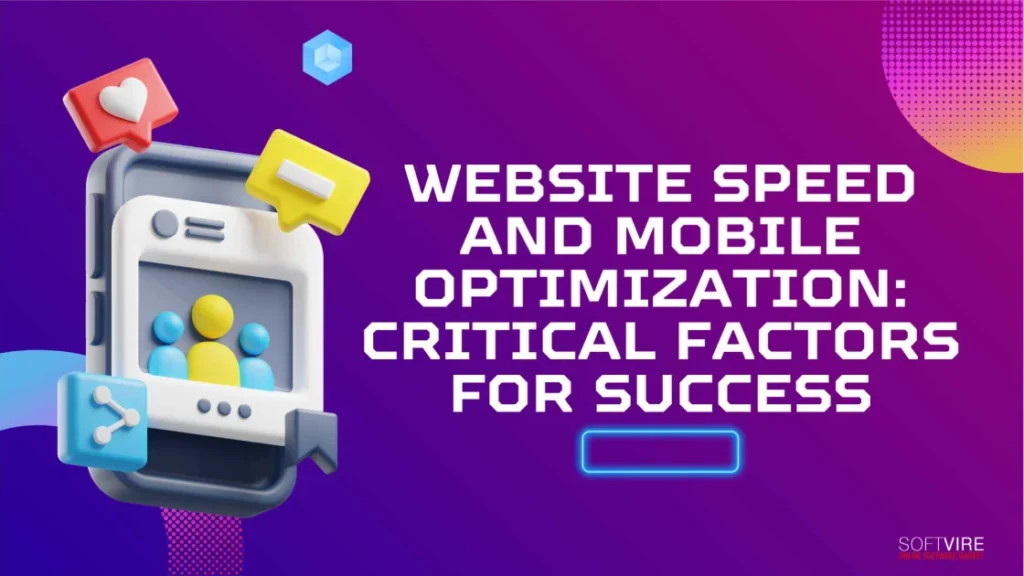In an age when internet presence is everything, the speed and mobile optimization of a website have emerged as foundational pillars for online success. These two critical factors are not only essential for enhancing user experience but also play a pivotal role in search engine rankings, audience engagement, and, ultimately, the success of a website. This discussion explores the significance of website speed and mobile optimization and their profound impact on the online landscape.
The Need for Speed
The time it takes for a webpage to load is not merely a convenience but a necessity in the digital age. Users today need more patience for slow-loading pages, and research indicates that even minor delays can lead to frustration and abandonment. Website speed matters for several compelling reasons:
- User Experience: A fast-loading website provides a seamless and enjoyable user experience, ensuring visitors can easily access content and navigate the site without delays or interruptions.
- Search Engine Ranking: Search engines, like Google, prioritize pages that load quickly. Websites that load quickly have a higher chance of ranking in search results, improving their visibility to potential users.
- Mobile Compatibility: Mobile users, who constitute a significant portion of internet traffic, often need more bandwidth and processing power. A fast website is crucial for retaining and engaging these users.
- Reduced Bounce Rates: A fast website minimizes bounce rates, meaning users are likelier to stay on the site and explore its content rather than leave in frustration.
- Improved Conversion Rates: Speedy websites lead to higher conversion rates, whether purchasing, signing up for a newsletter, or taking any desired action.
The Mobile Imperative
With the fast growth of mobile device usage, mobile optimization is now optional but imperative. This involves ensuring that a website is not only accessible on mobile devices but also delivers a top-notch user experience. Critical considerations for mobile optimization include:
- Responsive Design: Websites should be designed to accommodate various screen sizes and resolutions, offering a consistent and visually appealing experience across devices.
- Fast Loading on Mobile: Mobile users, often on slower network connections, demand fast-loading pages. Optimizing images, scripts, and other resources is crucial for this aspect.
- Touch-Friendly Navigation: Mobile optimization should include touch-friendly elements, making it easy for users to interact with the site using their fingertips.
- Content Accessibility: Content should be easily readable on small screens, and critical information should be readily accessible without excessive scrolling or zooming.
- Mobile SEO: Mobile-friendly websites are favored by search engines for mobile search results, contributing to overall search visibility.
The Intersection of Speed and Mobile Optimization
Website speed and mobile optimization are not isolated concepts but are intricately connected. Mobile users often need help with the double challenge of slower network connections and smaller screens. Hence, ensuring a website is fast and optimized for Mobile devices is critical for delivering a consistent and high-quality user experience.
In the digital age, the success of a website hinges on its ability to meet the demands of a diverse and increasingly mobile audience. By prioritizing speed and mobile optimization, website owners can not only attract and retain users but also gain a competitive edge in a landscape where performance and accessibility are non-negotiable. In this context, both speed and mobile optimization are not just critical factors for success but integral components of a thriving online presence.
Website speed and mobile optimization are not static goals but ongoing commitments. Regular monitoring and performance improvements are essential to maintain and enhance the user experience. Here are additional considerations for success:
- Continuous Testing and Optimization: Test the speed and mobile performance of your website regularly. Google PageSpeed Insights and GTmetrix are two tools that can help you find areas for improvement. Based on these findings, continue to optimize your website.
- Content Prioritization: On mobile devices, screen space is limited. Prioritize content and features to ensure the most critical information is readily accessible. Avoid overwhelming users with excessive content or features on smaller screens.
- Image Optimization: Large images are a common cause of slow-loading websites. Image optimization and compression can reduce file sizes without sacrificing quality. Consider using next-gen image formats like WebP.
- Caching: Implement browser and server-side caching to store frequently accessed data, reducing load times for returning users.
- Mobile-Friendly Navigation: Ensure navigation menus and interactive elements are easily used on mobile devices. Utilize hamburger menus, collapsible sections, and touch-friendly buttons.
- Accelerated Mobile Pages (AMP): Consider implementing AMP, a Google-backed project that offers an ultra-fast and simplified version of web pages for mobile users. It can significantly improve loading times for mobile visitors.
- Progressive Web Apps (PWAs): PWAs are websites that offer an app-like experience on mobile devices. They can work offline, load quickly, and offer push notifications, providing an enhanced mobile experience.
- User Feedback and Analytics: Collect user feedback and analyze mobile user behavior through tools like Google Analytics. This data can guide further improvements and optimization efforts.
- Local SEO: For businesses with physical locations, optimizing for local search is crucial. Ensure your website is mobile-friendly to improve local search rankings and increase visibility for nearby users.
- Security: A secure website is a fast website. Implement HTTPS to protect user data and improve trust. Search engines also favor secure sites in their rankings.
In today’s digital landscape, website speed, and mobile optimization are non-negotiable for businesses aiming to succeed online. Users expect seamless experiences on desktop and mobile devices, and search engines reward websites that meet these expectations. By continually improving speed and mobile optimization, businesses can maintain a competitive internet presence by engaging and accessible to a broad audience, ultimately contributing to their long-term success in the digital realm.
Conclusion
In the ever-evolving digital arena, the critical importance of website speed and mobile optimization cannot be overstated. They are not mere technical considerations but integral components of a successful online presence. The need for speed stems from users’ expectations for instant access and efficient interactions, while mobile optimization addresses the dominant role of mobile devices in the modern world. Recognizing the intersection of these two factors is critical to delivering a cohesive, high-quality user experience. Small businesses and website owners must view website speed and mobile optimization as ongoing commitments, ensuring their digital platforms remain accessible, engaging, and competitive in an environment where performance and accessibility are central to achieving online success.
Check out the different Microsoft software products today if you need trusted software that uses AI ethically and efficiently. Softvire continues to lead in using AI for its many office tools like Office 365. Get discounted Office 365 in Malaysia now!



